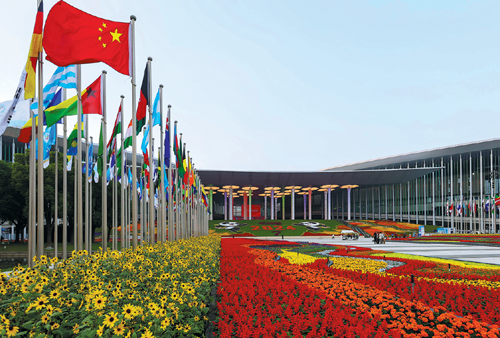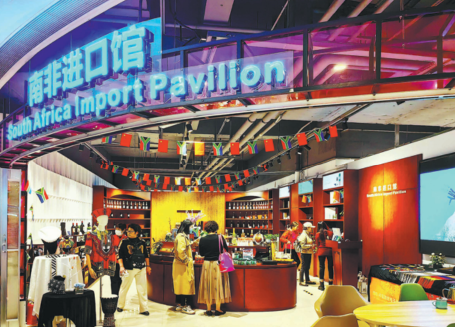New landmarks in Shanghai sweet home for brands
Gateway city's opening-up effort bears fruit as Hongqiao intl hub now a magnet for biz, consumers

Shopping at the ZZER secondhand luxury consignment store in Hongqiao has become something of a habit for 27-year-old Zheng Tingting, as she travels frequently from her hometown of Yancheng in Jiangsu province to Shanghai for business reasons.
Providing shoppers with various vintage luxury goods offered at appealing prices, the store is located near an exit of the subway station in the Hongqiao transportation hub, where passengers don't mind taking a few extra steps to check out what products are in stock.
"It only takes a five-minute walk from Exit C of the metro station to get to the store and you can easily spend three or four hours there, often finding things that you have been searching for a long time," said Zheng, who recently bought another handbag from the store.
The store was a bold attempt by ZZER, or zhi er in Chinese, as it used to mainly sell second-hand luxury goods via e-commerce. Then, in December 2022, ZZER opened the brick-and-mortar store near Hongqiao station and attracted more than 100,000 shoppers within the first six months. The company consequently expanded the initial 3,000-square-meter store to nearly 10,000 sq m in August 2023, and has thus far sold over 100,000 goods, from more than 5,000 international brands.
Zhu Tainiqi, ZZER's founder, said he once thought that only online users would come to the offline venue. To his great surprise, however, consumers from all over China, and even those from Europe, the United States and South Korea, have visited the store, and some of them are now frequent customers.
The upgrading work of the underground business area at The Hub Mall in Hongqiao, where ZZER's store is located, was completed in March, which Zhu said should help attract more customers.
The Hub Mall, covering a construction area of 380,000 sq m and comprising shopping areas, office buildings, a performance center and hotels, receives about 100,000 visitors on a daily basis. More than half of them are from neighboring cities such as Suzhou and Nanjing in Jiangsu, Hangzhou in Zhejiang province and Hefei in Anhui province.
International brands making their China debut by launching stores at The Hub Mall have served as a magnet to consumers. About 52 brands opened regional or national first stores in The Hub Mall last year, accounting for 40 percent of the total number of newly opened stores at the mall in 2024. This has helped the mall consolidate its position as Shanghai's first shopping destination for travelers, according to The Hub Mall's management team.
As understood by Liu Min, deputy director of the Shanghai Municipal Commission of Commerce, the uptrend of launching first stores can kindle new activities in the city's landmarks. This not only boosts consumption at restaurants and hotels, but also facilitates the concentration of businesses.
The opening of first stores can also nurture new business models. On a broader perspective, the presence of more first stores in the city has exemplified industrial upgrading and innovation at the consumption end. A new balance between supply and demand can be reached by introducing more first stores, Liu said.
The number of arrivals at the Hongqiao transportation hub — comprising terminals of an airport, high-speed railways, bus and metro lines — reached a record 438 million in 2024, equaling 1.2 million travelers daily. The number of travelers served by Shanghai Hongqiao International Airport reached 47.97 million last year, a new high.
A good example of how events can increase foot traffic was seen during the Puff Up Bread Festival held at The Hub Mall in late September 2023, the first of its kind to be held in the eastern part of China. On the first day, about 120,000 visitors participated in the festival and all of the bread prepared by the attending bakeries that day — 70,000 packs — were sold out. About 30 percent of the consumption that day was made by visitors from nearby cities.
Actually, translating the increased foot traffic into more economic momentum is part of the mission shouldered by the Hongqiao International Opening-up Hub, a 7,000-square-kilometer integrated development area covering parts of Shanghai, Jiangsu, Zhejiang and Anhui.
According to the framework construction plan of the Hongqiao International Opening-up Hub, which was approved by the State Council in February 2021, the planned area has grown into the country's largest modern comprehensive transportation center thanks to the traffic network in Hongqiao.
Aiming to complete the Hub's initial construction within this year, much progress has been made so far. The 151-sq-km Shanghai Hongqiao International CBD — at the heart of the Hub — saw its import and export value of goods surge by 13 percent year-on-year in 2024. Its tax income topped over 50 billion yuan ($6.84 billion) for the first time last year.
According to Lu Ming, a professor from Antai College of Economics and Management at Shanghai Jiao Tong University, the Hub's function is reflected by the integration of industrial chains and the facilitation of more consumption.
The presence of more leading retailers has helped with the achievements. Chinese sportswear giant Anta held a groundbreaking ceremony for its global retail headquarters in the Hub in December. Home appliances major Midea is expected to see its global innovation center located in the Hub accommodate the first employees in the second quarter of the year.
Various electric vehicle makers such as Li Auto and BYD have set up operations in the CBD. The launch of hotel brands including Cordis and Shangri-La has helped to facilitate the overall consumption environment, local officials have said.
Jin Xiaoming, head of Shanghai's Qingpu district, which is involved in the Hub, said thanks to the participation of industry leaders, Qingpu's overall retail sales surged by 14.9 percent last year. By integrating cultural, tourism, business, sports and agricultural sectors, the large transportation traffic in Hongqiao helped Qingpu's tourism income rise by 7.7 percent in 2024.
More retail space is underway to provide comprehensive shopping experiences. With a total construction area of 260,000 sq m, the Incity Mega shopping mall located in the Hub's Qiantan area is expected to open by the end of the year, accommodating over 350 brands. The new shopping mall is located just opposite the 20,000 sq m membership store Costco, which was also the brand's first on the Chinese mainland.
The China International Import Expo (CIIE), an annual event held at the National Exhibition and Convention Center (Shanghai) located in the Hub, has also played an important role in introducing more products into the Chinese market.
Greenland Global Commodity Trading Hub, a major "6+365" exhibition and trade platform recognized by the Shanghai Municipal Commission of Commerce, has set up 68 national pavilions, offering various imported products, since it went operational in November 2018.
Another similar platform, Hongqiao Import Commodity Exhibition and Trading Center, was put into operation in 2019. Currently, more than 85,000 products provided by over 6,000 brands from 120 countries are available at the center.
The center has now set up 33 branches nationwide, through which goods from all over the world can reach a wider range of consumers in China. Its two branches in Suzhou saw a combined sales revenue exceeding 200 million yuan in 2024.
Companies have debuted new products and opened their first stores via the CIIE, which helped to release more consumption potential in the Chinese market, said Liu Tao, a researcher specializing in market economy at the Development Research Center of the State Council.
By further improving the CIIE's bonded exhibition, international purchase and investment services, more brands will be attracted, which is conducive to the upgrading of China's consumption structure, he said.



Today's Top News
- Reducing burdens at the grassroots benefits the people
- Documentary revisits ping-pong days of 1971
- China signals potential trade talks for the first time
- Washington and Kyiv sign economic accord
- Strong fiscal, monetary policy support expected in pipeline
- US business community alarmed by tariff impacts






























